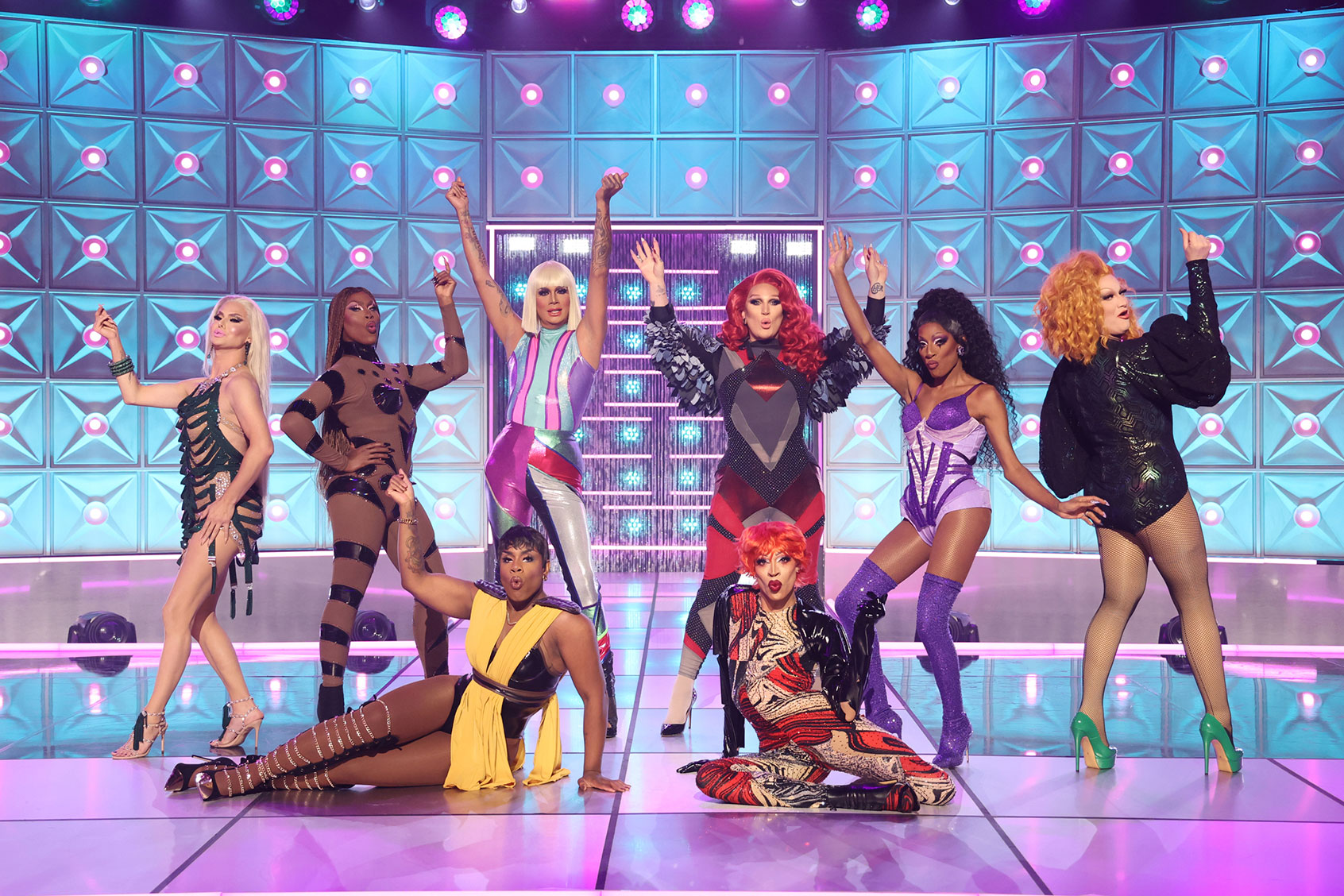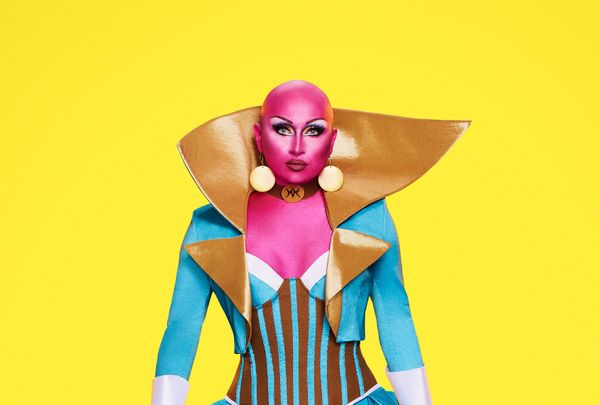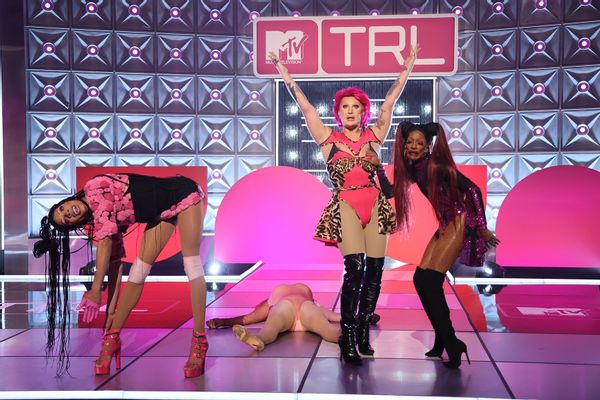
Drag queens are more popular than ever, but parents have recently been criticized for taking kids to family-friendly drag shows perceived to be inappropriate for children. Granted, not all drag shows are created for young audiences, but the art of drag is far-reaching, and it's making a difference for youth.
My middle son came out as gay at age 9. When I tell him that gay bars used to be raided by police or that drag queens were once arrested for their art, he finds this absurd. He's 12 now and, like so many young people, marvels at the queens on "RuPaul's Drag Race," their ability to express themselves and make a career doing it. He doesn't know the gritty side of drag; the booze-soaked, smoke-filled clubs and cabarets. Maybe he never will. Public perception and expectations around drag have changed. What matters is that my son knows there are people out there like him, people who celebrate an art form that has a sense of humor and elevates the human spirit. Drag isn't something to hide behind, it's powerful creative expression. As RuPaul says, drag is for everyone.
I was initially nervous about some of the language and sexual innuendo, but I felt he was mature enough to gain an understanding of these elements as they relate to drag performance. And let's face it, in the absence of policing every internet moment for our children, they will discover what they want to learn, with or without us.
To be a drag queen is to be reborn, over and over again, in an image of your own creation. This is empowering.
Visit any website or discussion board about recommendations for suitable viewing age and you will find mixed opinions. Some sites advise restricting viewership for "Drag Race" to 15-year-olds and up. Others have more liberal advice, but discussion among parents is variable. Some say their toddlers love the dazzling visuals and pretty contestants. Others abhor the language, suggestive sexual content, and occasional "nudity" (which, interestingly, some networks use censorship by way of blurring the nipples on fake breasts but not the real nipples of topless men).

As a mom, I made the decision to let my pre-teen watch the show because much of what children see on television, in movies, and online involves socially constructed ideas of gender and sexuality, even outright homophobia, transphobia and misogyny. I felt the truth about the culture with which he identifies was a step in the right direction. My own experiences as a fan of drag culture taught me about a complexity beyond female impersonation. It isn't "deceptive," as many heteronormative films depict the unwanted surprise under a dress, perpetuating a myth that gay men and trans women go around trying to trick straight people into unwanted sex. Drag is performance, art, and comedy. It requires a vast knowledge of pop culture and the wit to turn it into parody and satire. To be a drag queen is to be reborn, over and over again, in an image of your own creation. This is empowering.
Drag has become a part of mainstream pop culture and "RuPaul's Drag Race" has elevated the art form.
When "RuPaul's Drag Race" first aired in 2009, it had infamously terrible lighting. The sets looked cheap, but real queens performed in a drag pageant on TV. It was revolutionary. It was gay culture packaged as reality television. This was a time before the drag show had become a destination for brunches, stagettes and girls' nights, before drag queens became a commodity for general consumption. Today, terms like "reading," tucking" and "fishy" have entered the vernacular of "Drag Race" viewers, many of whom have never set foot at a live drag show. Celebrities and politicians have been guest judges. Outside of the show, audiences are devouring content like Tom Holland performing in drag for his turn as Rihanna or Channing Tatum as Beyoncé on "Lip Sync Battle," a show that has arguably been influenced by drag's staple performance. Drag has become a part of mainstream pop culture and "RuPaul's Drag Race" has elevated the art form.
RELATED: HBO's heartfelt "We're Here" is the drag show we all need right now
The show has been instrumental in bringing the art of drag to the mainstream. Through the commercialization of drag and the success of the show, RuPaul Charles has made the LGBTQ2+ community more visible and acceptable in mainstream popular culture. Drag has evolved from a necessarily underground subculture to a full-fledged art form. Today, youth looking to see themselves in the popular media can view "Drag Race" franchises in Canada, the United States, Australia and New Zealand, Brazil, Chile, France, Germany, Italy, Netherlands, Philippines, Spain, Sweden, Thailand, and the United Kingdom. The show has produced 14 seasons and inspired multiple spin-offs associated with the primary production, as well as DragCon trade shows in Los Angeles, New York, and London. Former contestants perform in worldwide tours and host shows of their own, propelled by the exposure they receive while competing in "RuPaul's Drag Race." The show has changed the face of drag, a historically subversive art form, and has become a beacon of visibility and hope for LGBTQ2+ youth.
Drag Race" is the contest that encourages individuality and self-love.
Drag's appeal to a wider audience, specifically women, is significant. The idea that drag toys with gender roles and notions of appropriation makes it inherently universal. The acceptance of "Drag Race" by the mainstream is progress, appreciation for queer history and art that was, until relatively recently, associated with deviance and shame. Previous generations of children grew up watching televised beauty pageants, measuring women against the impossible standards of bathing suit competitions and rehearsed responses to patronizing and patriarchal questions. Today, "RuPaul's Drag Race" has those same elements of glamour and fashion, but the contestants are expressing themselves, not conforming to beauty standards that objectify and oppress. Contestants are challenged to create runway garments from dollar store junk and dumpster dives, write stand-up comedy and choreograph complex dance routines. "Drag Race" is the contest that encourages individuality and self-love.

Changes have also been made around some of the language used on the show to accommodate an increased awareness around offensive and outdated terminology. This shift emphasizes the need for adaptability in the evolving landscape of LGBTQ2+ communities. RuPaul often uses the phrase, "With great power comes great responsibility," and he is living this by admitting to past mistakes and making space for all identities on the show. As a parent and ally, these issues have sparked conversations with my kids about the language we use and the importance of inclusion. Over 14 years, the show has evolved to become more inclusive, mirroring the positive changes happening in wider society.
RuPaul has said that, historically, the public perception of gay culture had been largely informed by gay pornography. Since the rise of "Drag Race," that perception has changed.
There's a tradition on "RuPaul's Drag Race" where the finalists in the competition address photos of their younger selves. RuPaul holds up images of the queens as cherubic toddlers or wide-eyed grade schoolers and asks the final four contenders to offer words of advice to their inner children. This is the episode that brings almost everyone to tears, judges included, as wisdom is dispensed about staying strong through relentless bullying, parental abandonment, and a lifetime of low self-esteem. Occasionally, one of the participants describes a childhood filled with unconditional love, support, and encouragement that allowed them to thrive and become their best, most confident selves. They talk about parents who took on the task of educating themselves about queer culture, helped design costumes, showed up for every drag show. I can't help but imagine my son, all grown up, talking to the image of his younger self. I want him to be buoyed to success by the support of his family. As a mom to a tween son who came out as gay three years ago, these poignant moments with the finalists clinch the importance of a reality show that celebrates an art form steeped in the rich history of queer culture and activism.

RuPaul has said that, historically, the public perception of gay culture had been largely informed by gay pornography. Since the rise of "Drag Race," that perception has changed. Popular culture has always been influenced by gay culture, but "Drag Race" has cleared a path for a television drama series like "Pose" (based on the New York City drag ball scene), a myriad of shows hosted by drag queens on streaming platforms and YouTube, and younger kids taking to social media to express their true nature. Desmond Is Amazing is a child who began his art of drag early, learning from RuPaul and the other queens on the show. He has performed in the New York Pride Parade, walked in New York Fashion Week runways, and appeared in Vogue. Public facilities are hosting programs such as the Calgary Public Library's "Reading with Royalty" series, celebrating inclusion and diversity with drag queens and kings reading stories to young children. CBC Gem is streaming "Drag Kids," a documentary profiling four children as they prepare for a performance in an all-ages drag ball at Montreal Pride. Drag Syndrome is a group of London performers with Down Syndrome who have embraced the art of drag. The winner of the first season of "Canada's Drag Race," Priyanka, is former YTV (children's network) host Suki. Another famous Canadian queen, Kendall Gender, calls herself a "sober queen" and makes a point of doing all-ages shows, something she feels makes a difference for kids looking for their own identities and communities. These initiatives speak volumes about the cultural shift that has taken place through mainstream acceptance. Drag is no longer tucked (so to speak) away in the underground. The art of drag has changed, and the audience is growing to include new generations of fans with enlightened expectations.
This focus on self-love is one of the most positive aspects of the show, instilling confidence and self-esteem in the participants as well as young viewers struggling with their identities and relationships.
In 2017, RuPaul released the song "Call Me Mother," a reference to being a drag mother, the maternal role taken on by seasoned queens who mentor those coming up in the industry. Often, the relationship forms out of necessity, survival for gay and genderqueer young people who have been thrown out by their birth families. Some drag mothers provide food and shelter. Others impart their skills and resources, helping new drag queens to sew costumes, land gigs and gain exposure. Like a true mom, RuPaul encourages the queens to protect their health and practice self-care. He repeats his now-famous motto at the end of every episode, "If you can't love yourself, how in the hell are you gonna to love somebody else?" My son has a T-shirt with this maxim. It has become the "Drag Race" mantra. This focus on self-love is one of the most positive aspects of the show, instilling confidence and self-esteem in the participants as well as young viewers struggling with their identities and relationships.
Want a daily wrap-up of all the news and commentary Salon has to offer? Subscribe to our morning newsletter, Crash Course.
My middle son is 12 now and knows details about famous drag queens the way sports fans keep statistics on their favourite athletes. We have front row meet-and-greet seats for the "Canada's Drag Race" Tour this summer. I can't wait to see the look on his face when he meets his favourite queens up close. Some would call me a bad parent for letting my child watch "RuPaul's Drag Race" or taking him to a drag show. In parts of the United States, Republicans are trying to pass a bill to ban kids from drag shows and call social services on parents like me. In a society bursting with images of women and girls as sex objects, rampant gun violence, and hate driven by ignorance, I'm glad my kids can enjoy an art form that starts the conversation about queer history, oppression, and activism. My son sees himself reflected in these artists, and his brothers are growing up with exposure to a culture that normalizes this diversity. It's part of educating all of us about our evolving societal landscape.
"RuPaul's Drag Race" is streaming on Paramount+.
Read more
about this topic







